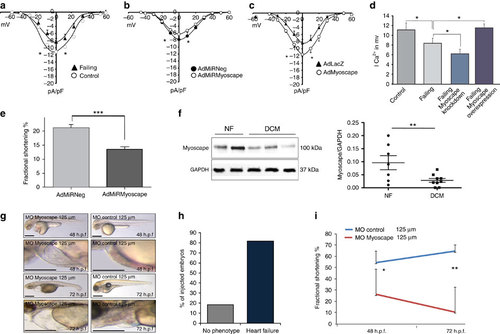- Title
-
Myoscape controls cardiac calcium cycling and contractility via regulation of L-type calcium channel surface expression
- Authors
- Eden, M., Meder, B., Völkers, M., Poomvanicha, M., Domes, K., Branchereau, M., Marck, P., Will, R., Bernt, A., Rangrez, A., Busch, M., German Mouse Clinic Consortium, Hrab? de Angelis, M., Heymes, C., Rottbauer, W., Most, P., Hofmann, F., Frey, N.
- Source
- Full text @ Nat. Commun.
|
(a) Measurements of whole-cell L-type calcium currents in failing rat ARVCMs isolated from rat hearts after cryoinfarction, compared with non-failing (sham operated) controls at baseline or (b) after adenoviral Myoscape knockdown or (c) Myoscape overexpression, respectively (n=7-9, *P<0.05 (ANOVA)). (d) Summary of the L-type calcium currents under different experimental conditions, showing either restoration of calcium currents or a further reduction depending on Myoscape protein content. (n=7, *P<0.05 (ANOVA)) (e). To elucidate the functional consequences of myoscape downregulation on cardiomyocyte contractile function, again adult ventricular rat cardiomyocytes were utilized. On the first day of culture, ARVCMs where infected with AdMiRMyocape or control virus (AdMiRNeg). Fractional shortening was assessed by video edge detection evaluated by an observer blinded to experimental conditions. ARVCMs infected with AdMiRMyoscape showed a significant reduction in fractional shortening compared with ARVCM?s infected with control virus (21±1% versus 14±1%, in 60 assessed cells, and n=3 independent cell preparations, ***P<0.001 (ANOVA)). (f) Downregulation of Myoscape protein content was shown via western blot analyses in biopsies from patients suffering from end-stage heart failure due to dilated cardiomyopathy (DCM) and compared with control heart samples from individuals who died from a non-cardiovascular-cause (n=7-8). GAPDH served as a loading control (left panel). A statistical evaluation was done of all samples showing a significant decrease of Myoscape/GAPDH ratios. **P<0.01 (ANOVA). (g) Morpholino knockdown of zebrafish Myoscape results in severe contractile dysfunction. Myoscape knockdown morphants (lateral view) develop pericardial oedema and blood congestion due to low cardiac performance. By contrast, cardiac function of MO-control injected zebrafish embryos was unaffected after 48 or 72 h.p.f. (h) Quantitative evaluation showing 81.7% of Myoscape knockdown morphant zebrafish developing cardiac failure after injection. The presence of heart failure was assessed by evaluation of reduced ventricular function and development of pericardial oedema and precardial signs of blood congestion. Functional assessment of cardiac contractility was carried out by a Zeiss MCU II microscope with the help of the zebraFS software. (i) Fractional shortening (FS) of the ventricular chamber of wild-type and Myoscape-deficient embryos measured at different developmental stages (48 and 72 h.p.f.). *P<0.05; **P<0.01 (ANOVA). Scale bars, 25 µm. PHENOTYPE:
|
|
(a left panel) RT -PCR analysis in zebrafish hearts from Myoscape knockdown morphants compared to controls showed a successful splice site mutation as indicated by a clear double band. (a right panel) Western blot analysis of zebrafish hearts from Myoscape knockdown morphants compared to controls, revealing a significant (>60%) reduction of Myoscape protein content after morpholino injection. (b+d) Histological (HE staining, scale bar 100µm), immunohistochemical (scale bar 100µm) (c) and ultrastructural evaluation of zebrafish heart (e) sections and skeletal muscle tissue (f) showing no gross architectural deficits after Myoscape ablation, indicating no obvious role of Myoscape in development or cellular sub-architecture of these tissues in zebrafish (scale bar EM 1 µm). EXPRESSION / LABELING:
PHENOTYPE:
|


